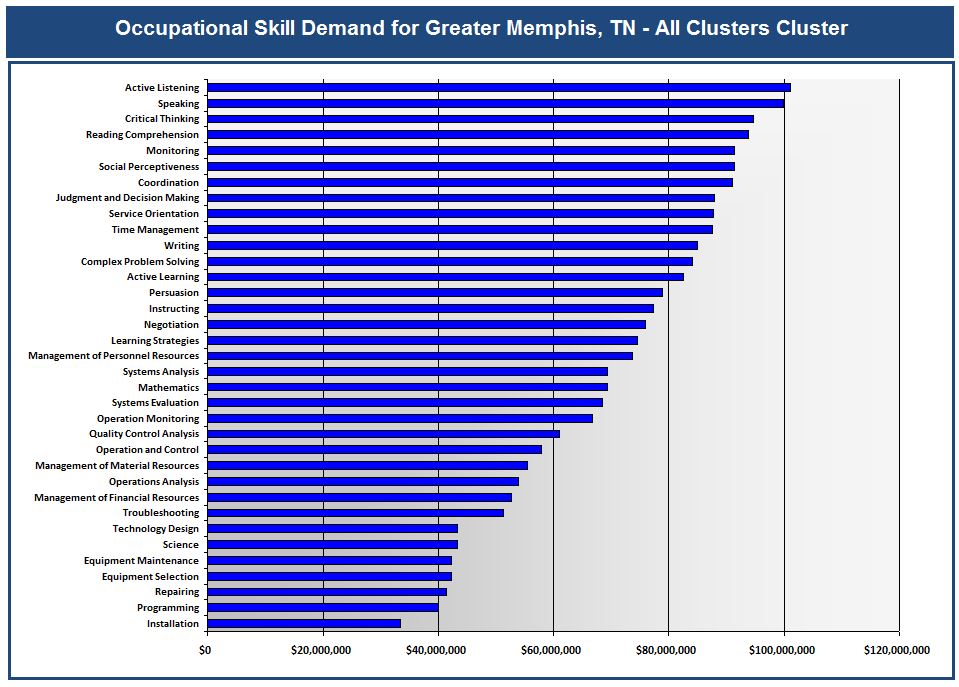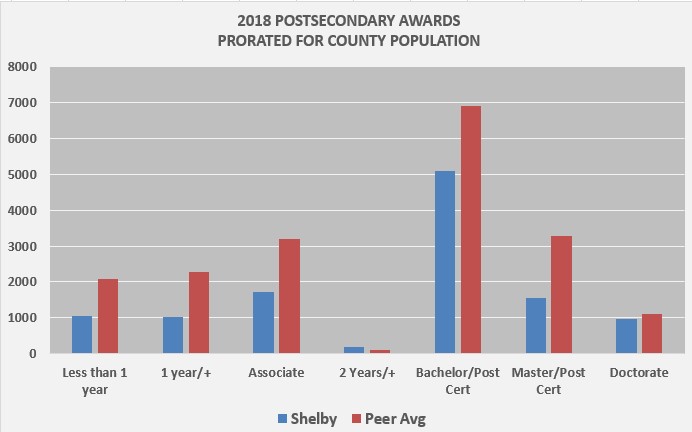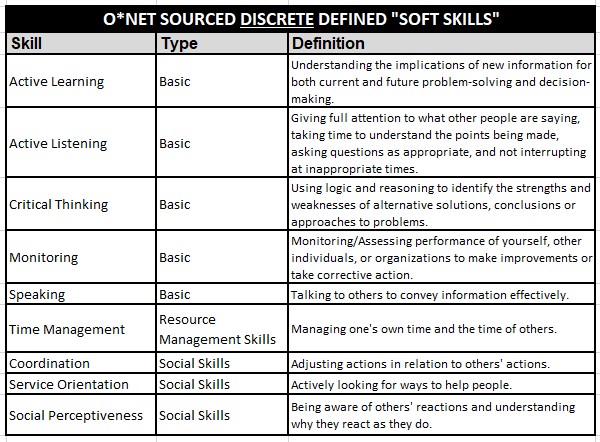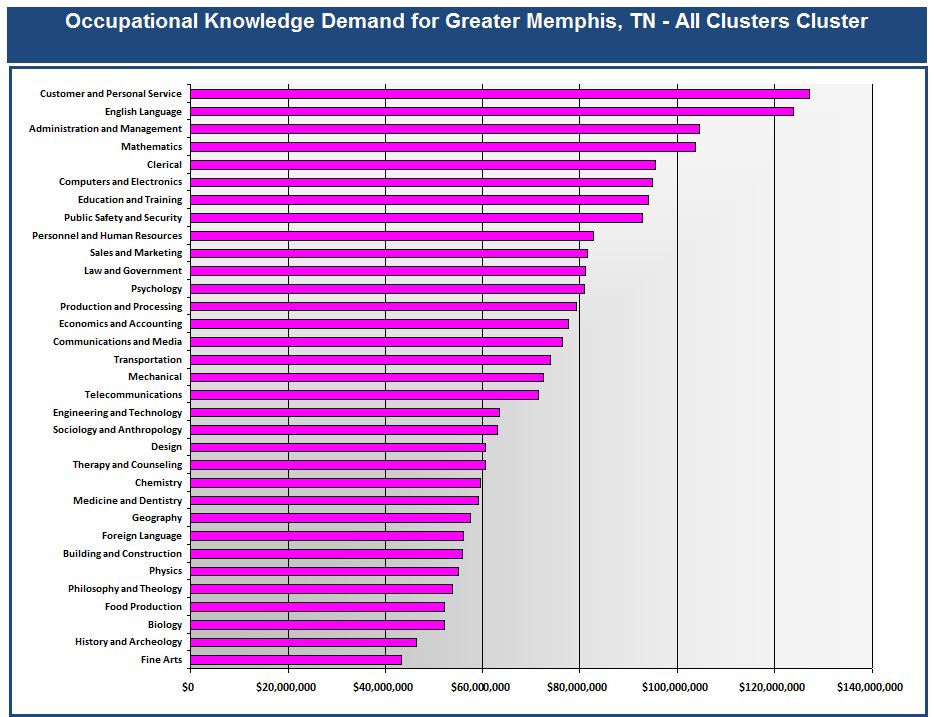After my most last blog, a local personality emailed me stating that in the UpSkill901 Education Pillar session we both attended, there appeared to be cloudy communication disconnects between community stakeholders from diverse professional backgrounds. Additionally, the personality was looking for a data source to track post-secondary completion progress. In our shared session regarding talent pipeline development, business professionals were communicating in terms of “customer mapping” and educators were communicating in other terms to describe the process of student career navigation which includes self exploration, career exploration and career planning.
The primary need coming out of UpSkill901 was a research based connected workforce development plan with a common language framework to support productive conversations between professionally diverse stakeholders while eliminating silos. While being a net positive for the community, the benefits of the recent UpSkill901 Chamber event were to alert the community of the coming disruption from automation, convening workforce stakeholders and identifying service gaps. Further gaps include the need for local subject matter expertise to critically evaluate instructional technology to avoid pitfalls of the recent past while insuring research based implementation.
The above questions would be answered within a connected research based workforce development plan that facilitates common language development. Again, from the previous blog, fundamentals of any connected workforce development plan and deployment of career pathways consists of “common language” development with 1) a unifying measurable definition for “career readiness” applicable to diverse target audiences 2) employer demand data, 3) occupationally aligned assessments, preferably universally recognized to support economic development efforts, 4) career pathways curriculum alignment and planning, 5) professional development and typically 6) centralized technology to reduce implementation costs.
All of the former elements contribute to common language development which reduce communication disconnects while facilitating productive communication between diverse stakeholders. Its not important that everyone is a subject matter expert (SME) in all things related to workforce development but it is important that SMEs exist somewhere in the system and that all stakeholders are aware of authoritative data supports and research based best practices to support common language, productive communication and implementation of connected employer demand workforce development efforts.
While the local establishment has been incumbent on exporting workforce development programming to out of town entities, implementation has not occurred in the “long haul” of connected workforce development implementation over the past 5 years. This has cost taxpayers an estimated $1B in wages and $30M in deficient recurring tax revenues. All of this has occurred, as LOSBs have been dismissed while formally proposing research based connected solutions on the record and through published blogs.
One of the most efficient ways the establishment can improve lagging small business vitality is by increasing transactional velocity in the system with LOSBs when credible ready to go LOSB solutions are proposed to course correct and solve community problems. Dismissing LOSBs with the ‘long haul” staple, in “well workforce development is going to be a long haul”, as services effectively go undelivered over 5 years, is a lose-lose prescription for LOSBs, economic development and the community at large while also lowering expectations and accountability for expeditious service delivery. Sadly, Memphis has never really got started with the “long haul” of connected workforce development programming.
And it must be said, that none of the outside entities nor have any of the local workforce development nonprofits proposed the need for a connected workforce development plan or a framework for such a plan over the past 5 years all while LOSBs proposals have been dismissed. Still wonder why small business vitality struggles in Memphis ?
Anyway, the outside think tanks of Brookings and Burning Glass were successful at communicating the upskill need for the coming automation disruption while establishing expectations for lifelong learning. But the data slides presented seemed designed to impress rather than communicate as they were, at least to me, complex and hard to digest while not getting reinforced with a closer view in the breakout sessions. It would seem more simple slides could have been used to answer more foundational questions like 1) How does Shelby County fare versus its peers in educational attainment ? 2) What are and define “soft skills”? and 3) What skills and knowledge are most in demand?
To that extent, this blog will expand on fundamental common language supports that should be included in a connected workforce development plan to help answer those more basic questions.
Common Language Data Supports
While a bit dry, the following is a sampling of authoritative public domain data sources that facilitate common language development and measurement within the workforce development system. In most cases, these sources are foundational and leveraged by third party providers to provide services. For this reason, its important that SMEs exist somewhere in the system to understand how proprietary data interacts with data in the public domain and how computations are performed.
As an example, through subject matter expertise, accountability can be enforced while avoiding computational debacles that contribute to local imbalances such as those computations of Younger and Associates related to inflated EDGE tax revenue projections. See below workforce development data sources and then we will bust out a few use cases to answer those basic questions initially broached:
Occupational Characteristics. The O*NET database content model contains various score requirements for over 800 occupations in relationship to a standardized common language framework of 35 discrete skills, 33 areas of knowledge, 16 work styles, 5 education and training levels, 41 generalized work activities, 57 work contexts and 52 abilities for a total of 239 descriptors. The O*NET data collection effort is administered by Research Triangle Institute in conjunction with the United States Department of Labor and serves as an authoritative source for common language development within the workforce development system. The statistically reliable O*NET database is routinely used as a primary or baseline data source in a vast array of proprietary products. An example use case for ONE*T, from the recent UpSkill901 event, would have been to better define “soft skills” with specific discrete skills from the O*NET subcategory skills of basic, social and resource management skills. The chart at the top of this section uses O*NET as a data source to communicate projected skill demand for all occupations. This same chart can be produced for selected career clusters as well as individual occupations.
Postsecondary Data. Integrated Postsecondary Education Data System (IPEDS)- IPEDS forms the institutional sampling framework for other NCES surveys, such as the National Postsecondary Student Aid Study and the National Survey of Postsecondary Faculty. This data source can help regional consortiums understand regional occupational supply to inform completion rate progress and regional occupational supply/demand studies. These studies help to guide the selection and development of career pathways as well as regional career pathway promotion and program offering. The raw data from IPEDS requires SME compilation as it is not intuitive upon download. See this sampling of downloaded IPEDS data. ( https://nces.ed.gov/ipeds)
Occupational Wages. Occupational Employment Statistics (OES) – Program produces employment and wage estimates annually for over 800 occupations. These estimates are available for the nation as a whole, for individual States, and for metropolitan and nonmetropolitan areas. National occupational estimates for specific industries are also available. This data helps learners consider wages in career exploration and employers and policymakers understand wage trends to support occupational demand analysis (http://www.bls.gov/oes/).
Occupational Projections. Projections Central (State Occupational Projections) – Projections of occupational employment growth are developed for all States and the nation as a whole. One of the most important uses of projections is to help individuals make informed career decisions. Information on this site allows projected employment growth for an occupation to be compared among States. It also allows projected employment growth among occupations to be compared within one State when accessing state specific sites. The data source further helps regional consortiums access regional projections to understand demand for select career pathways, promotion and offerings to support economic development efforts while helping learners evaluate career choices based on projected openings for a given occupation (http://www.projectionscentral.com/Home/Index ).
Industrial Sector Employment Demand. Quarterly Census of Employment and Wages (QCEW) – Program publishes a quarterly count of employment and wages reported by employers covering 95 percent of U.S. jobs, available at the county, MSA, state and national levels by industry. This data source can help regional consortiums deploy demand driven industry sector strategies (http://www.bls.gov/cew/).
Career Pathways. Career Pathways is a series of connected education and training strategies and support services that enable individuals to secure industry relevant certification and obtain employment within an occupational area while advancing to higher levels of education and employment. Comprehensive standardized mapping of classification of instructional programs (CIP) codes and O*NET/SOC occupational codes into career clusters and career pathways is provided. This data can help locals relate their program offering to career clusters and occupations -(http://cte.ed.gov/).
The above data can be leveraged and deployed via a centralized technology portal in various forms to facilitate cost effective common language development.
To the extent technology is used, a research based connected workforce development plan provides an architecture for which proprietary tools generally and technology tools exist in an overall connected workforce development system. A research based plan would provide a framework for evaluating proprietary technology tools while subject matter expertise could help facilitate evaluation of technology tools. In this way, technology implementation occurs and scales while delivering services in a timely manner.
Common Language Data Use Cases
Now to some use cases and back to those basic questions: 1) How does Shelby County fare versus its peers in educational attainment ? 2) What are and define specific soft skills ? and 3) What skills and knowledge are most in demand ? See below:
Prorated for population and using IPEDS data, the chart below shows the gap in postsecondary educational attainment awards versus the average of 15 Shelby County peers throughout the country to include Louisville, Indianapolis, Nashville, Tulsa and etc.
Using O*NET as an authoritative data source, the below chart lists discrete soft skills and their definitions
A chart listing of the most in demand skills while using O*NET as a foundational data source. As shown, the most in demand skills are for the most part soft skills, thus the soft skill emphasis. This data would ideally be used to inform the academic and basic skills curriculum for all learners.
A listing of areas of knowledge most in demand by local employers based on projected demand. As one can see, “customer and personal service” should be thematic throughout local curricular experiences as it is most in demand across all occupations.
The “Long Haul” Tenant and Lowering of Expectations
While the above LOSB suggestions could serve the overall good, the “long haul” tenant is often unfortunately used in local establishment discussions. The “long haul” tends to dash any meaningful expectations in the short term and ultimately results in a lack of accountability as near term milestones are non-existent while lowering expectations and starving out small business with limited resources.
But at any rate, here is a ready to go research base framework to facilitate connected workforce development planning efforts. And then there is also the TIFNI tool, another LOSB innovation, that addresses a huge local process hole in tax abatement projection accounting…..





